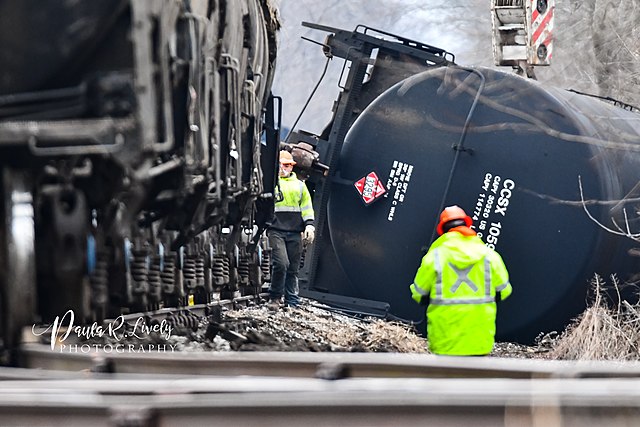(Wikimedia Commons)
As smoke rose above the quaint Ohio town of East Palestine, just 180 miles from our school, its citizens were stuck in a waiting game following the derailment of a train carrying hazardous substances on February 3. The controlled burn of these toxic chemicals cast a dark–-and possibly deadly–-cloud of smoke over their homes. Residents were evacuated, thousands of chickens and fish died, and questions about how this catastrophe will affect them now and in the future have persisted as they tried to determine whether it was safe enough to return home.
An axle failed due to a mechanical defect, causing the derailment of about 50 train cars from Norfolk Southern to divert from the tracks. Eleven of the cars were carrying toxic chemicals. Five of them had vinyl chloride. These trains held known toxic chemicals that are linked to causing cancer: vinyl chloride, butyl acrylate, ethylene glycol, isobutylene, and ethylhexyl acrylate. Vinyl chloride, in particular, has been linked to increasing a person’s risk of developing liver, lung, and brain cancer, lymphoma, and leukemia. The chemicals’ dangerous effects were evident immediately. Residents reported symptoms of eye and skin irritation, headaches, nausea, dizziness, vomiting, drowsiness, and diarrhea.
Norfolk Southern recommended the controlled burn of the vinyl chloride, fearing that it might explode otherwise. But Norfolk Southern misled officials and the community when it initially wanted to burn only one car but then expanded it to all five cars carrying this chemical, which resulted in a larger plume of smoke and far more pollution. The burning of this chemical releases dioxins which may cause those who breathe it in to develop cancer, infertility, type 2 diabetes, heart disease, and other immune disorders.
The Norfolk Southern train company took minimal safety initiatives and neglected to inform the small northeastern Ohio community that a train with toxic cargo was passing through its town. Moreover, Norfolk Southern failed to inform the residents in a timely manner of the dangers of these substances.
In a comparison between first-person accounts on social media vs. the information being shared on major news outlets, it is hard to decipher what is true, what is misinformation, and what is intentionally left out as the company attempts to minimize damages.
Initially, most of the shared information on the derailment came from first-person accounts on social media, spreading across TikTok and Twitter like wildfire. After the first couple of weeks, users began reporting the peculiarities of how the government and Norfolk Southern were handling the situation. Residents living in East Palestine and those who stayed up-to-date on environmental events were frustrated that this disastrous event was not dominating mainstream news coverage. While national news outlets, like CNN, reported the derailment, it took a massive outcry on social media for mainstream media to take serious coverage of the accident.
Nick Drombosky, an influencer that posts educational videos on TikTok, has become one of the app’s most prominent sources for unfiltered information about the derailment. Drombosky noted that a week after the initial list of chemicals in the crash was reported, the company updated it to include more potentially toxic compounds. He also discovered that the models Norfolk Southern used to determine the evacuation radius were based on “best-case” weather conditions that were unrealistic on the day the train derailed.
Officials do not yet know exactly what the long-term effects will be for the people of East Palestine, yet they continue to tell residents not to worry. But scientists predict there will be future dangers and potential health complications because of the sheer amount of burning chemicals at the site.
The slow response of Norfolk Southern and local, state, and federal officials will only increase the risk of future health ramifications from contaminated water supplies and inhaling these chemicals.
Although officials claimed the water was safe, citizens of East Palestine continue to have concerns, particularly as some have symptoms consistent with exposure to vinyl chloride. On February 21, Governor Mike DeWine, EPA Administrator Michael Regan, and U.S. Rep. Bill Johnson traveled to East Palestine to assuage the fears of the residents. The politicians even drank some of the town’s water. Regan claimed, “This village water is safe.” He added that the water was “pretty good.” But this gesture was not reassuring to the citizens of East Palestine who do not just take a singular sip like DeWine. The people of East Palestine have to drink this water, take showers, bathe their children, and cook with it. This is not the same as DeWine’s insignificant sip.
Efforts to support the people of East Palestine have been inadequate. This is not an affluent area, and the median household income of these residents is approximately half the national average. Norfolk Southern offered only $1,000 per household for relocation costs. This certainly will not cover the expenses for a lengthy relocation, nor will it be enough to defray the cost of possible medical issues as a result of the spill.
Norfolk Southern only agreed to provide aid to East Palestine residents and those in Pennsylvania living near the accident. Those not living within the divided boundaries, however, got nothing, and are rightfully displeased.
The state and federal government must conduct an independent review of this disaster and improve safety measures for trains carrying hazardous materials. The previous administration rolled back a 2015 rule requiring faster brakes on trains with toxic cargo. Thus, this rule must be reinstated and Norfolk Southern needs to be held accountable for the damage it caused.
The long-term effects of the train derailment are unknown presently, but scientific evidence suggests that the residents will likely suffer the consequences of a corporation’s inadequacy. Norfolk Southern owes the people of East Palestine an explanation, an apology, and long-term financial support to mitigate the environmental and human toll of this tragedy.








